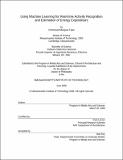| dc.contributor.advisor | Kent Larson. | en_US |
| dc.contributor.author | Munguia Tapia, Emmanuel, 1978- | en_US |
| dc.contributor.other | Massachusetts Institute of Technology. Dept. of Architecture. Program in Media Arts and Sciences. | en_US |
| dc.date.accessioned | 2009-03-20T19:31:34Z | |
| dc.date.available | 2009-03-20T19:31:34Z | |
| dc.date.copyright | 2008 | en_US |
| dc.date.issued | 2008 | en_US |
| dc.identifier.uri | http://hdl.handle.net/1721.1/44913 | |
| dc.description | Thesis (Ph. D.)--Massachusetts Institute of Technology, School of Architecture and Planning, Program in Media Arts and Sciences, 2008. | en_US |
| dc.description | This electronic version was submitted by the student author. The certified thesis is available in the Institute Archives and Special Collections. | en_US |
| dc.description | Includes bibliographical references (p. 481-493). | en_US |
| dc.description.abstract | Obesity is now considered a global epidemic and is predicted to become the number one preventive health threat in the industrialized world. Presently, over 60% of the U.S. adult population is overweight and 30% is obese. This is of concern because obesity is linked to leading causes of death, such as heart and pulmonary diseases, stroke, and type 2 diabetes. The dramatic rise in obesity rates is attributed to an environment that provides easy access to high caloric food and drink and promotes low levels of physical activity. Unfortunately, many people have a poor understanding of their own daily energy (im)balance: the number of calories they consume from food compared with what they expend through physical activity. Accelerometers offer promise as an objective measure of physical activity. In prior work they have been used to estimate energy expenditure and activity type. This work further demonstrates how wireless accelerometers can be used for real-time automatic recognition of physical activity type, intensity, and duration and estimation of energy expenditure. The parameters of the algorithms such as type of classifier/regressor, feature set, window length, signal preprocessing, sensor set utilized and their placement on the human body are selected by performing a set of incremental experiments designed to identify sets of parameters that may balance system usability with robust, real-time performance in low processing power devices such as mobile phones. The algorithms implemented are evaluated using a dataset of examples of 52 activities collected from 20 participants at a gymnasium and a residential home. The algorithms presented here may ultimately allow for the development of mobile phone-based just-in-time interventions to increase self-awareness of physical activity patterns and increases in physical activity levels in real-time during free-living that scale to large populations. | en_US |
| dc.description.abstract | (cont.) KEYWORDS: Activity recognition, context awareness, energy expenditure, physical activity, wearable sensors, obesity, mobile phone, pattern recognition, machine learning, ubiquitous, pervasive, just-in-time. | en_US |
| dc.description.statementofresponsibility | by Emmanuel Munguia Tapia. | en_US |
| dc.format.extent | 493 p. | en_US |
| dc.language.iso | eng | en_US |
| dc.publisher | Massachusetts Institute of Technology | en_US |
| dc.rights | M.I.T. theses are protected by
copyright. They may be viewed from this source for any purpose, but
reproduction or distribution in any format is prohibited without written
permission. See provided URL for inquiries about permission. | en_US |
| dc.rights.uri | http://dspace.mit.edu/handle/1721.1/7582 | en_US |
| dc.subject | Architecture. Program in Media Arts and Sciences. | en_US |
| dc.title | Using machine learning for real-time activity recognition and estimation of energy expenditure | en_US |
| dc.type | Thesis | en_US |
| dc.description.degree | Ph.D. | en_US |
| dc.contributor.department | Program in Media Arts and Sciences (Massachusetts Institute of Technology) | |
| dc.identifier.oclc | 300459396 | en_US |
